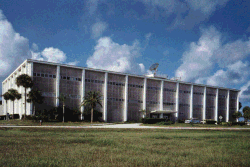
The John F. Kennedy Space Center, located on Merritt Island, Florida, is one of the National Aeronautics and Space Administration's (NASA) ten field centers. Since 1968, KSC has been NASA's primary launch center of American spaceflight, research, and technology. Launch operations for the Apollo, Skylab and Space Shuttle programs were carried out from Kennedy Space Center Launch Complex 39 and managed by KSC. Located on the east coast of Florida, KSC is adjacent to Cape Canaveral Space Force Station (CCSFS). The management of the two entities work very closely together, share resources, and operate facilities on each other's property.

The NASA Deep Space Network (DSN) is a worldwide network of spacecraft communication ground segment facilities, located in the United States (California), Spain (Madrid), and Australia (Canberra), that supports NASA's interplanetary spacecraft missions. It also performs radio and radar astronomy observations for the exploration of the Solar System and the universe, and supports selected Earth-orbiting missions. DSN is part of the NASA Jet Propulsion Laboratory (JPL).

The Vehicle Assembly Building, or VAB, is a large building at NASA's Kennedy Space Center (KSC) in Florida, designed to assemble large pre-manufactured space vehicle components, such as the massive Saturn V, the Space Shuttle and the Space Launch System, and stack them vertically onto one of three mobile launcher platforms used by NASA. As of March 2022, the first Space Launch System (SLS) rocket was assembled inside in preparation for the Artemis I mission, launched on November 16, 2022.

Robert Laurel Crippen is an American retired naval officer and aviator, test pilot, aerospace engineer, and retired astronaut. He traveled into space four times: as pilot of STS-1 in April 1981, the first Space Shuttle mission; and as commander of STS-7 in June 1983, STS-41-C in April 1984, and STS-41-G in October 1984. He was also a part of the Manned Orbiting Laboratory (MOL), Skylab Medical Experiment Altitude Test (SMEAT), ASTP support crew member, and the Approach and Landing Tests (ALT) for the Space Shuttle.
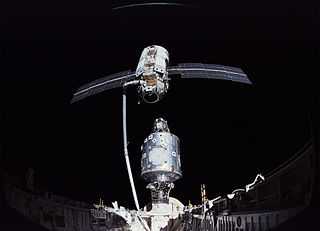
STS-88 was the first Space Shuttle mission to the International Space Station (ISS). It was flown by Space Shuttle Endeavour, and took the first American module, the Unity node, to the station.
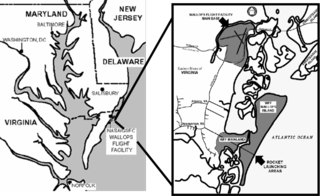
Wallops Flight Facility (WFF) is a rocket launch site on Wallops Island on the Eastern Shore of Virginia, United States, just east of the Delmarva Peninsula and approximately 100 miles (160 km) north-northeast of Norfolk. The facility is operated by the Goddard Space Flight Center in Greenbelt, Maryland, and primarily serves to support science and exploration missions for NASA and other federal agencies. WFF includes an extensively instrumented range to support launches of more than a dozen types of sounding rockets; small expendable suborbital and orbital rockets; high-altitude balloon flights carrying scientific instruments for atmospheric and astronomical research; and, using its Research Airport, flight tests of aeronautical research aircraft, including unmanned aerial vehicles.

Launch Complex 39 (LC-39) is a rocket launch site at the John F. Kennedy Space Center on Merritt Island in Florida, United States. The site and its collection of facilities were originally built as the Apollo program's "Moonport" and later modified for the Space Shuttle program. Launch Complex 39 consists of three launch sub-complexes or "pads"—39A, 39B, and 39C—a Vehicle Assembly Building (VAB), a Crawlerway used by crawler-transporters to carry mobile launcher platforms between the VAB and the pads, Orbiter Processing Facility buildings, a Launch Control Center which contains the firing rooms, a news facility famous for the iconic countdown clock seen in television coverage and photos, and various logistical and operational support buildings.

A mobile launcher platform (MLP), also known as mobile launch platform, is a structure used to support a large multistage space vehicle which is assembled (stacked) vertically in an integration facility and then transported by a crawler-transporter (CT) to a launch pad. This becomes the support structure for launch.

The Kennedy Space Center Visitor Complex is the visitor center at NASA's Kennedy Space Center on Merritt Island, Florida. It features exhibits and displays, historic spacecraft and memorabilia, shows, two IMAX theaters, and a range of bus tours of the spaceport. The "Space Shuttle Atlantis" exhibit contains the Atlantis orbiter and the Shuttle Launch Experience, a simulated ride into space. The center also provides astronaut training experiences, including a multi-axial chair and Mars Base simulator. The visitor complex also has daily presentations from a veteran NASA astronaut. A bus tour, included with admission, encompasses the separate Apollo/Saturn V Center. There were 1.7 million visitors to the visitor complex in 2016.

The Rocco A. Petrone Launch Control Center is a four-story building at NASA's Kennedy Space Center on Merritt Island, Florida, used to manage launches of launch vehicles from Kennedy Space Center Launch Complex 39. Attached to the southeast corner of the Vehicle Assembly Building, the LCC contains offices; telemetry, tracking, and instrumentation equipment; and firing rooms.
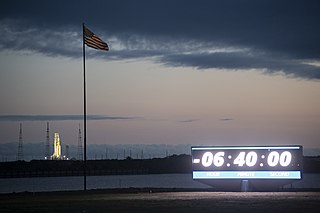
The Launch Complex 39 Press Site is a news media facility at Launch Complex 39 at the John F. Kennedy Space Center (KSC) on Merritt Island, Florida where journalists have observed every U.S. crewed space launch since Apollo 8 in 1968. The site is just south of the Vehicle Assembly Building (VAB); 3 miles (4.8 km) west-southwest of Pad A, and 3.4 miles (5.4 km) southwest of Pad B.

The Neil Armstrong Operations and Checkout Building (O&C) is a historic building on Merritt Island, Florida, United States. The five-story structure is in the Industrial Area of NASA's Kennedy Space Center. Its has twin-block facilities that include the crew quarter dormitories for astronauts, suit-up preparations prior to their flights, and the other is a large spacecraft workshop used for manufacturing and checking activities on crewed spacecraft. On January 21, 2000, it was added to the U.S. National Register of Historic Places.

The Space Systems Processing Facility (SSPF), originally the Space Station Processing Facility, is a three-story industrial building at Kennedy Space Center for the manufacture and processing of flight hardware, modules, structural components and solar arrays of the International Space Station, and future space stations and commercial spacecraft. It was built in 1992 at the space complex's industrial area, just east of the Operations and Checkout Building.

NASA's Christopher C. Kraft Jr. Mission Control Center, also known by its radio callsign, Houston, is the facility at the Lyndon B. Johnson Space Center in Houston, Texas, that manages flight control for the United States human space program, currently involving astronauts aboard the International Space Station (ISS). The center is in Building 30 at the Johnson Space Center and is named after Christopher C. Kraft Jr., a NASA engineer and manager who was instrumental in establishing the agency's Mission Control operation, and was the first Flight Director.
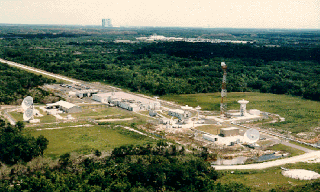
The Merritt Island Spaceflight Tracking and Data Network station, known in NASA parlance as MILA, was a radio communications and spacecraft tracking complex located on 61 acres (0.25 km2) at the Kennedy Space Center (KSC) in Florida. The name MILA was an acronym for the "Merritt Island Launch Annex" to Cape Canaveral Air Force Station, which was how the site was referred to when spacecraft launches were primarily originating from the adjacent military installation. MILA's arrays of antennas provided various communications and data services between spacecraft and NASA centers, as well as tracked and ranged moving spacecraft. In its final years, it served as the primary voice and data link during the first 7½ minutes of Space Shuttle launches, and the final 13 minutes of shuttle landings at KSC. Though it occupied land at KSC, MILA was operated and managed by the Goddard Space Flight Center.
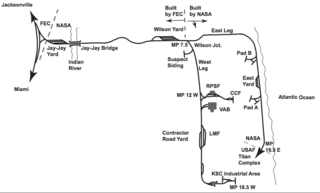
The NASA Railroad is a Class III industrial short-line railroad at the Kennedy Space Center in Cape Canaveral, Florida. The railroad consists of 38 miles (61 km) of track connecting the mainline of the Florida East Coast Railway and trackage at the Cape Canaveral Space Force Station. NASA uses the railroad to deliver large or bulk materials to support its operations, particularly solid rocket boosters and chemicals such as helium and oxygen for rocket fuel.
Hypergol Maintenance and Checkout Facility was a rocket fuel and engine complex located in an isolated part of the Kennedy Space Center industrial area. It was constructed in 1964 to support the Apollo program and upgraded in 1985 to support the Space Shuttle program. The hypergolic propellants used in the Space Shuttle's reaction control system, Orbital Maneuvering System, and the auxiliary power units provided hydraulic power to the shuttle's control surfaces, main engines and brakes were stored and processed in part of the complex. Part of the facility was used for cryogenic testing during the Apollo program and Solid Rocket Booster aft skirt hot-testing.
There are NASA facilities across the United States and around the world. NASA Headquarters in Washington, DC provides overall guidance and political leadership to the agency. There are 10 NASA field centers, which provide leadership for and execution of NASA's work. All other facilities fall under the leadership of at least one of these field centers. Some facilities serve more than one application for historic or administrative reasons. NASA has used or supported various observatories and telescopes, and an example of this is the NASA Infrared Telescope Facility. In 2013 a NASA Office of the Inspector General's (OIG) Report recommended a Base Realignment and Closure Commission (BRAC) style organization to consolidate NASA's little used facilities. The OIG determined at least 33 of NASA's 155 facilities were underutilized.
As the coalition of Bay Areas counties predicted when it lobbied for the creation of Moffett Federal Airfield in the late 1920s, the base's research program and facilities catalyzed the development of numerous private technology and aerospace corporations, among them Lockheed Martin and the Hiller Aircraft Corporation.

The project to create the International Space Station required the utilization and/or construction of new and existing manufacturing facilities around the world, mostly in the United States and Europe. The agencies overseeing the manufacturing involved NASA, Roscosmos, the European Space Agency, JAXA, and the Canadian Space Agency. Hundreds of contractors working for the five space agencies were assigned the task of fabricating the modules, trusses, experiments and other hardware elements for the station.
